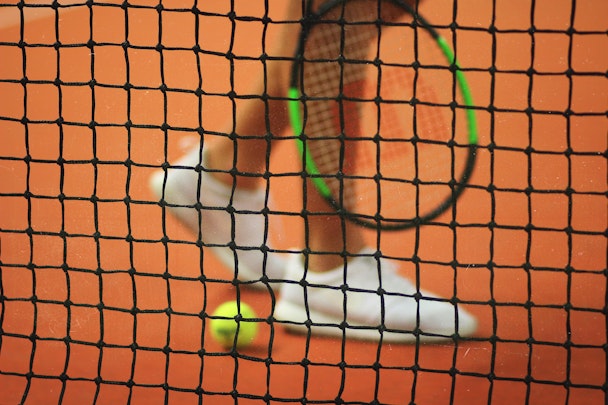What can advertisers learn from the legendary Wimbledon x Robinsons partnership?
Wimbledon is in full swing, with the first year since the 1930s that the event isn’t being sponsored by drinks brand Robinsons. Time will tell why the change is happening, but here we’re looking at what marketers can learn from that formidable doubles team and others like it. We asked six leaders from The Drum Network (including a former Robinsons brand manager and someone forging new Wimbledon relationships) about the partnerships that inspire them, and how marketers can create relationships that truly last.

How can brands go about cultivating partnerships like Robinsons x Wimbledon? / John Fornander via Unsplash
David Durnford, chief executive officer, Reading Room (and former Robinsons brand manager)
Creating a new relationship is one thing. Maintaining it takes ongoing commitment.
During my time as brand manager at Robinsons, I recognized that the real value that Wimbledon found in us was far more than just a transactional relationship. We had a synergy, a real authenticity behind our shared values and mutual interests, which was vital to the 86-year success that these brands shared.
The trust and respect between brands and agencies come from the people within. Disputes happen; but the ability to empathetically understand people makes these relationships stronger.
Brands and agencies should remove their transactional thought process. It’s incredibly important for both parties to recognize that the best work comes from people who are inspired; not those having to deal with a dictatorial and over-demanding account.
At Reading Room, we find that our best clients are those who don’t see our relationship as merely a transaction, but as a unique collaboration between people who seek success.
Advertisement
Tom Ellis-Jones, UK client services director, Momentum Worldwide
In the best brand partnerships, the brand becomes synonymous with the event or property it sponsors.
A long-standing partnership built over a number of years embeds itself in the memory. It’s the authenticity that really reaps rewards.
It’s hard to believe that Guinness sponsoring the Six Nations dates back to just 2019. There’s been a connection between Guinness and rugby for time immemorial, but now the Six Nations deal is done, it just fits; the two are already completely synonymous. RBS, sponsor from 2003 to 2017, must be kicking itself for how rapidly its equity in the tournament has dissolved away.
At Wimbledon, there’ll be a nostalgic sigh at the passing of the Robinsons partnership. But times are changing at SW19. The tournament’s host, the All England Lawn Tennis and Croquet Club (AELTC), has an appetite for growth, a drive for innovation, and an ambition to expand its reach to new audiences across new markets. Global brands such as Evian, American Express and Lavazza are now more aligned to the club’s global aspirations, as proven by the activation that the AELTC is creating in partnership with Momentum Worldwide, bringing the iconic Hill to Brooklyn Bridge Park over Finals weekend this week.
While these are relatively new partnerships, the goal remains the same: to become synonymous with the property and realize those common objectives.
Advertisement
Jon Goynshor, head of partnerships, VMLY&R Commerce
It takes vision, shared values, chemistry, return-on-investment and even a little luck for a collaboration to endure. Wimbledon and Robinsons’ ‘cordial’ end to their 86-year partnership may leave a bad taste for a while, but will be remembered as a legendary match that celebrated all those essential ingredients.
A few other storybook collaborations at the intersection of culture and commerce inspired my partnership marketing career, starting with James Bond’s affinity for Aston Martins tracing back to the original Ian Fleming novels. I loved seeing how this iconic entertainment marketing collaboration spanning over 60 years recently featured models from the past, present and future in No Time To Die.
Given my Chicago roots, I was also inspired by the Coke and McDonald’s partnership conceived in 1955 in my hometown by a handshake deal. This collaboration showcased Ray Kroc’s entrepreneurial vision and the shared business objectives to grow and expand around the world. These revolutionary alliances inspired me to contribute to Cadbury’s first-ever pairing, the long-term partnership with Peter Rabbit, both synonymous with Easter gifting and family celebrations. Here’s hoping our collective contributions will influence the next generation of partnership marketers.
Suggested newsletters for you
Creating meaningful connections between consumer passion points and properties is the goal of any successful partnership. In partnership discussions, the opportunity cost of exclusivity is a factor. It’s getting harder to protect, and becoming increasingly expensive.
Once a brand gives up exclusivity, it can rarely be recaptured. In many cases, properties use this to increase total revenue by fragmenting categories across competitive brands. When a brand is in renewal discussions, they’ll need to ask these questions, among others:
-
What will be lost if exclusivity is given up?
-
What could be gained by reinvesting those funds?
For Robinsons, the decision to walk away from its long-standing Wimbledon relationship is reflective of its belief (presumably backed by data and consumer insights) that its sponsorship fee will work harder when reinvested elsewhere (including its summer 2022 campaign ‘The Big Fruit Hunt’). While it is exiting the agreement, it will receive residual association for years to come given the length of the partnership. Wimbledon will have an opportunity to bring on a global brand reflective of the broad appeal and reach of the event.
Chris Dowse, director of integrated strategy, Jaywing
Some brand partnerships burn bright and briefly. Think Primark x Greggs or Primark x Stranger Things. Then there are partnerships that create something more timeless, leveraging the best of both brands to elevate themselves, hand-in-hand. This relies on nailing down the overlap in mission, values or audience understanding to create something fresh, familiar and resonant.
We see a lot of studies claiming consumers want brands to reflect their own values. When two brands combine around a set of shared values, they create something new, cementing their places in existing markets and exposing them to new ones.
Many brands will take advantage of the zeitgeist with partnerships that tap into cultural peaks, but if two brands can come together and make their collaboration ‘stronger together’ and synonymous with belief systems and lifestyles, that’s when you’re on to a long-term winner. The longstanding relationship with GoPro x Red Bull is born of an alignment with action, adventure and high-energy adrenaline-fueled activity.
Rebecca Wilkes, client services director, Summit Media
The best relationships are two-way. They’re built on a solid foundation of communication and trust, with open and honest dialogue. Far too often, agencies promise the world to win a new deal or increase retainers. Then reality sets in, performance doesn’t improve, the client becomes challenging and the relationship falls apart.
Marketing is complex, with a lot of micro and macro factors at play. Being honest and upfront about expectations, forecasted performance and how quickly brands will start to see results is crucial for avoiding challenging conversations. It’s also important to agree between parties how success will be measured. Once agreed, this needs to be communicated throughout the business to ensure all stakeholders are aligned.
Continuing the open dialogue and communication throughout is key to ensuring the relationship really lasts. Develop stakeholder mapping at both sides, engage in regular face-to-face time, and always look for opportunities to gather ongoing feedback to further shape the relationship (either directly or via surveys).
Content created with:

Reading Room
Welcome to the home of the down-right inquisitive.
A clever person once said, “A problem defined, is a problem half-solved,” which is why 20 years on...

Momentum Worldwide
Momentum Worldwide is a global experience agency partnering with and transforming the world’s most famous brands since 1987. Built on the simple truth that it’s...
Find out more
VML
VML is a leading creative company that combines brand experience, customer experience, and commerce, creating connected brands to drive growth. VML is celebrated...
Find out more
Jack Morton
No one sets out to be average. No one aspires to be ordinary. Jack Morton is an award-winning global brand experience agency that exists to reimagine what an experience...
Find out more
Jaywing
At Jaywing, we’ve made it our mission to help clients establish concrete foundations in a world of shifting sands. As a data-powered integrated agency, we bring...
Find out more
Summit
We help brands transform their online business, grow their customer base and make more money from retailing online. In a complex digital marketing world that is...
Find out more
